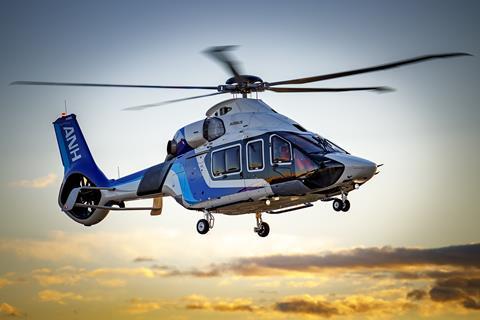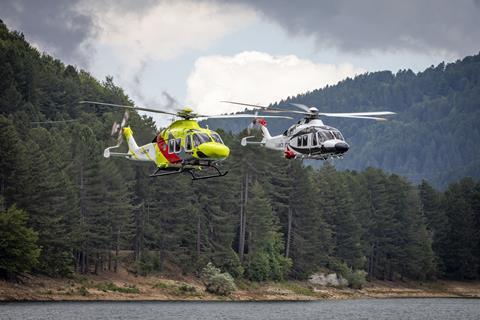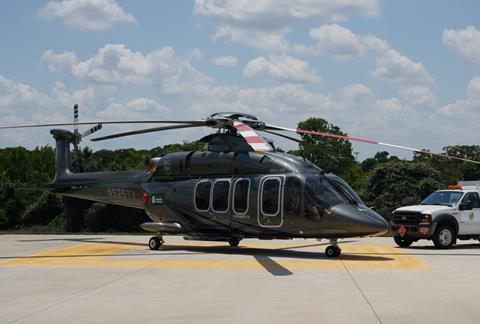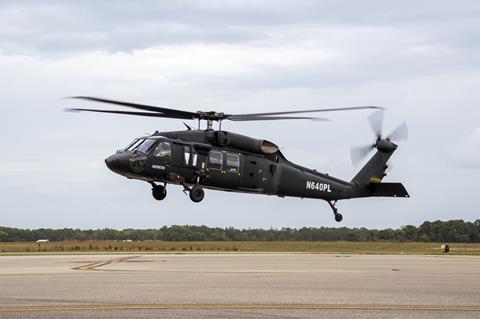Bruno Even, Airbus Helicopters chief executive, says 2021 was a “turning point” for the global rotorcraft industry, offering “the first sign of recovery” from the pummeling dealt by Covid-19 the previous year.
Overall, the market demonstrated a 40% year-on-year increase over 2020, says Even, albeit after activity that year was around 50% down on 2019.

“2020 will represent a low point from which we will recover progressively,” he says. “We expect the coming years to confirm to this positive evolution.”
However, he estimates that it will take two to three years for the industry to return to the prior order and again deliver at levels seen in 2019.
European rival Leonardo Helicopters has yet to publish its full-year delivery totals, but comments late last year from Gian Piero Cutillo, managing director of the airframer, tend to support Even’s view.
Cutillo said that the division would beat guidance in 2021, aided by a resurgent civil market: in just nine months it had more than doubled the number of helicopters it sold the previous year. “The signs of the recovery are clear,” he says. While a full return to 2019 levels still may take two to three years, he says, the recovery is occurring faster than previously forecast.
Airbus remains by some way the largest manufacturer of civil and parapublic helicopters globally: its preliminary figures suggest it took a 52% share of deliveries into that market last year – based on turbine helicopters with more than five seats – ahead of Bell (16%), Leonardo (16%), Russian Helicopters (10%), Sikorsky (3%), and others (3%).
Although Airbus says it delivered 338 helicopters last year, up from 300 the year before, it does not specify how many were to military customers. Bell, however, says it shipped 156 civil helicopters in 2021 – up on 140 in 2020. (Any discrepancy between the Airbus and Bell figures is presumably due to the exclusion of the latter’s five-seat 505 – a helicopter outside the scope of the former’s calculations.)
Airbus also saw a significant year-on-year improvement in order activity – 414 against 268 – with particular growth in the light-single segment, where it competes with the H125 and H130.
INCREASED POWER
Sales of the H125 should be bolstered by European Union Aviation Safety Agency (EASA) approval in April for an upgrade on the type, increasing the power available from the helicopter’s Safran Arriel 2D engine by 10% to 952shp (710kW). Although the enhancement does not change the H125’s maximum take-off weight (MTOW) of 2,250kg (4,960lb), external and internal load lifting capabilities grow by up to 140kg, while the ceiling for hovering out of ground effect at MTOW is increased by more than 1,500ft.
The higher power rating is standard on all new-build examples, while a retrofit modification is also available. US certification for the enhancement has also been obtained.
For the H160 – the newest model in Airbus Helicopters’ range – 2021 was somewhat of a curate’s egg. On the one hand, orders were strong at 52 units, including 40 from the French government, 30 of which are the first tranche for the country’s military under the HIL programme. Those orders were confirmed in December and signal the start of development work on the H160M Guepard ahead of first delivery in 2027.
But on the downside, the medium-twin has still to secure US Federal Aviation Administration (FAA) approval or enter service. Airbus was supposed to secure the first of those milestones in 2021 – following on from EASA certification in June 2020 – which would then quickly lead to the second, but there is still no sign of US validation. Instead, the first example has been shipped to Japan’s All Nippon Helicopter and is expected to start operations later this year.
Over at Leonardo Helicopters, work continues to finish certification on a pair of long-running development programmes. The AW609 civil tiltrotor appears to be close to the end of a trek that has lasted decades; certification test flights are due to wrap up this August and FAA approval is likely to follow this year – although service entry might not happen before 2023.
Meanwhile, the manufacturer is staying silent on when the Kopter AW09 light-single – the former SH09 – might be signed off. Flight tests began at the end of last year to validate aerodynamic improvements to the upper cowlings, with trials of new main rotor blades also commencing early this year. “The new cowlings bring the aircraft closer to its final certification shape,” the company says.
They are the latest evolution of the helicopter which has seen many aspects of the original design change, including the rotor mast, flight controls and fuselage aerodynamics.

Separately, EASA has approved two performance improvement packages for the AW169, boosting the medium-twin’s payload in several operating conditions. The ‘Enhanced’ performance pack will become the baseline for new-build helicopters, while the ‘Superior’ pack will be available as an option. Certain enhancements will be available as a retrofit, providing the helicopter’s software is to the phase 6 standard.
Both performance packs comprise an engine shaft horsepower increase, an enhanced transmission rating, software modifications to the FADEC on the AW169’s Pratt & Whitney Canada PW210A engines and to the helicopter’s avionics, plus changes to the tail structure.
Power available at take-off increases by 90shp and 130shp under the Enhanced and Superior packages, respectively, from a baseline of 874shp. Combined with the higher transmission ratings, Leonardo says this provides the 4,800kg MTOW AW169 with “the best-in-class power-to-weight ratio”.
Changes to the design of the tail – originally introduced on the skid-equipped version – are also incorporated in the upgrade in order to “maximise the advantage of the extra power available”. These consist of an airflow deflector on the right-hand-side of the tail cone, and reshaped winglets on the horizontal stabliser, which are also manufactured from a new material.
Just as Airbus and Leonardo are still working to achieve FAA certification for the respective H160 and AW609 rotorcraft, Bell also faces the same challenge with its 525 Relentless. Test flights and paperwork remain outstanding, but the US manufacturer appears confident that the super-medium-class helicopter is nearing the end of a development cycle that began in 2012.
“This is going to be a good year for the 525, to progress for certification,” Bell chief executive Mitch Snyder told reporters on 18 January. “We are getting closer and closer to that finish line,” adds programme director Derek Mookhoek. However, the airframer declines to say when that might occur, pointing out that the schedule is in the FAA’s hands.
Powered by two 1,714shp GE Aviation CT7-2F1 turboshafts, the 16-passenger 525 will have 580nm (1,074km) of range and cruise at 160kt (296km/h).
MULTIPLE MISSIONS
The company is pitching the type for various missions, including VIP, troop transport, search and rescue, and offshore oil and gas transport.
Last autumn, Bell took the demonstrator on a customer tour, completing 45 flights and carrying some 400 people. It showcased the aircraft to oil and gas companies in Louisiana and Mississippi and to potential foreign buyers in Washington DC.

But sales potential in the offshore market is unclear. For example, Airbus continues to see slow order intake for its super-medium-class H175 – just four units were sold in 2021 and none in 2020; Even sees the cause as a “market challenge rather than a competitiveness issue”, noting that “requests for super-medium and heavy helicopters are still low”.
Although the price of oil has risen steadily since hitting a low point in early 2020 – with Brent Crude on 26 January topping $90 a barrel for the first time since 2014 – “we have not yet seen an impact on the oil and gas market for helicopters”, says Even, who thinks it “will take time to recover”.
However, he sees “opportunity in the coming period” as operators look to renew their fleets, even of heavier helicopters like the Sikorsky S-92. The H175, he says, “can perform most of the missions of the S-92 at a much lower cost”.
Bell director of business development Tim Evans views the slightly heavier 525 in a similar light. “It’s going to perform almost like a heavy,” he says. “We are seeing a lot more interest in the aircraft.”
But while the uncertain oil and gas market is causing problems for Western manufacturers, Russian Helicopters has seized the opportunity to develop a new variant of Mil Mi-171, with a 15min hovering first flight of the A3 model taking place in December.
Designed for offshore transport missions, the Mi-171A3 includes a new airframe which integrates a crash-resistant fuel system into the cargo bay floor. It also features modernised avionics, which have been upgraded for offshore operations and flights in the Arctic. Widespread use of composite materials has also cut airframe weight over the A2 variant, the airframer says. Crucially, it will also meet international oil and gas transport standards.
Development of the latest variant of the heavy-twin began in 2018; Rb1 billion ($13.5 million) in funding for the project was allocated by the Russian trade and industry ministry in 2020.
The model’s MTOW is 13t, and range is 540nm – a 108nm increase on the current A2 – with capacity for 24 passengers.

Russian Helicopters in 2021 also launched upgrades for the Kamov Ka-226T and Ka-32A11M, and finally obtained certification for a third type, the 6.8t Ka-62 medium-twin.
Unveiled in 2012, flight tests of the Safran Ardiden 3G-powered Ka-62 did not begin until 2017. However, since then the three-strong test fleet amassed around 700h across 434 flights. Russian Helicopters intends to launch full-scale production this year as it bids to ship a total of 24 units over the next three years.
In addition, Russian Helicopters will offer a domestically-built engine on the type, with the Klimov VK-1600 currently in development.
Perhaps the most surprising move last year though came from Sikorsky, which announced that it had secured US civil certification for its newly designated S-70M Black Hawk, opening the door to wider commercial sales of the previously military-only helicopter.

To be built in Poland by its PZL Mielec subsidiary, the S-70M is covered by a FAA restricted category airworthiness certificate that limits its operations to three core missions: agricultural operations; external cargo carriage; and forest and wildlife conservation, which includes aerial firefighting missions.
Although non-military parapublic users such as the California Department of Forestry and Fire Protection already operate the S-70i Firehawk, this is enabled through the FAA’s public use rules, which do not apply to commercial operators.
California public utility San Diego Gas & Electric took delivery of the first civil S-70M on 18 November at the Sikorsky Training Academy in Stuart, Florida. The helicopter will be modified to the Firehawk configuration and enter service in 2023.
Sikorsky in 1988 obtained FAA approval for the S-70A – a commercial derivative of the UH-60A.
Additional reporting by Jon Hemmerdinger in Fort Worth


























